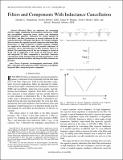| dc.contributor.author | Neugebauer, Timothy C. | |
| dc.contributor.author | Phinney, Joshua W. | |
| dc.contributor.author | Perreault, David J. | |
| dc.date.accessioned | 2014-05-09T19:53:47Z | |
| dc.date.available | 2014-05-09T19:53:47Z | |
| dc.date.issued | 2004-03 | |
| dc.date.submitted | 2003-12 | |
| dc.identifier.issn | 0093-9994 | |
| dc.identifier.issn | 1939-9367 | |
| dc.identifier.uri | http://hdl.handle.net/1721.1/86933 | |
| dc.description.abstract | Electrical filters are important for attenuating electrical ripple, eliminating electromagnetic interference (EMI) and susceptibility, improving power quality, and minimizing electromagnetic signature. Capacitors are critical elements in such filters, and filter performance is strongly influenced by the capacitor parasitics. This paper introduces a new design technique that overcomes the capacitor parasitic inductance that limits filter performance at high frequencies. Coupled magnetic windings are employed to effectively cancel the parasitic inductance of capacitors, and to add inductance in filter branches where it is desired. The underlying basis of the new technique is treated in detail, and its application to the design of both discrete filters and integrated LC filter components is described. Numerous experimental results demonstrating the high performance of the approach in both discrete filters and integrated filter elements are provided. | en_US |
| dc.description.sponsorship | United States. Office of Naval Research (Grant N00014-00-1-0381) | en_US |
| dc.description.sponsorship | United States. Office of Naval Research (Grant N00014-02-1-0481) | en_US |
| dc.language.iso | en_US | |
| dc.publisher | Institute of Electrical and Electronics Engineers (IEEE) | en_US |
| dc.relation.isversionof | http://dx.doi.org/10.1109/TIA.2004.824487 | en_US |
| dc.rights | Article is made available in accordance with the publisher's policy and may be subject to US copyright law. Please refer to the publisher's site for terms of use. | en_US |
| dc.source | Vabulas | en_US |
| dc.title | Filters and Components With Inductance Cancellation | en_US |
| dc.type | Article | en_US |
| dc.identifier.citation | Neugebauer, T.C., J.W. Phinney, and D.J. Perreault. “Filters and Components With Inductance Cancellation.” IEEE Trans. on Ind. Applicat. 40, no. 2 (March 2004): 483–491. © 2004 IEEE | en_US |
| dc.contributor.department | Massachusetts Institute of Technology. Department of Electrical Engineering and Computer Science | en_US |
| dc.contributor.department | Massachusetts Institute of Technology. Laboratory for Electromagnetic and Electronic Systems | en_US |
| dc.contributor.approver | Perreault, David J. | en_US |
| dc.contributor.mitauthor | Neugebauer, Timothy C. | en_US |
| dc.contributor.mitauthor | Phinney, Joshua W. | en_US |
| dc.contributor.mitauthor | Perreault, David J. | en_US |
| dc.relation.journal | IEEE Transactions on Industry Applications | en_US |
| dc.eprint.version | Final published version | en_US |
| dc.type.uri | http://purl.org/eprint/type/JournalArticle | en_US |
| eprint.status | http://purl.org/eprint/status/PeerReviewed | en_US |
| dspace.orderedauthors | Neugebauer, T.C.; Phinney, J.W.; Perreault, D.J. | en_US |
| dc.identifier.orcid | https://orcid.org/0000-0002-0746-6191 | |
| mit.license | PUBLISHER_POLICY | en_US |
| mit.metadata.status | Complete | |
